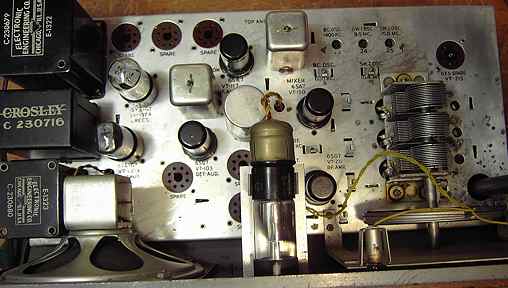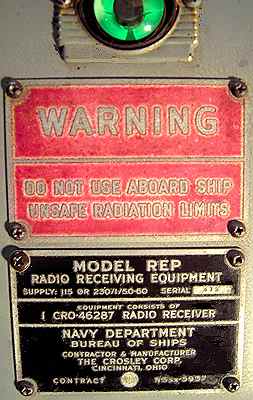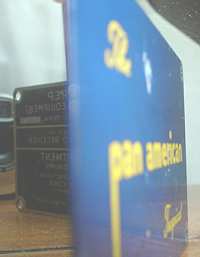
This Navy REP receiver was made by Crosley. It is Navy part number CRO-46287 made under Contract N5sx-5937. Serial number 473. A tag on the rear of the cabinet noted it was accepted by the Navy on 12-6-45.

The REP is a transformer-powered World War II era Navy morale receiver that can be switched to either 110 or 220 volts AC. It has 7 active tubes and sockets for 7 spares, including a socket for a spare 6E5 tuning eye. The receiver covers the AM broadcast band from 540 to 1610 KHz and two short wave bands from 5.8 to 15.8 MHz. Practically every adjustment is labeled on the chassis making it easy to locate alignment points. The schematic with alignment instructions is glued inside the cabinet.
Crosley also made an AC-DC wood-case 6 tube broadcast-only version for the Navy which was designated the REO and was Navy part number CRO-46286, Contract N5sr-7246, delivery date was 12/13/45. I am assuming the "CRO" stood for Crosley as the manufacturer. Both the REP and the REO were morale receivers. Both have provisions for connecting a phonograph input.


The Pan American Tropical and the Navy REP
Surplus Navy REP receivers was sold to civilians as the "Pan American Tropical" . Click here to see the Pan American Tropical at the Museum of Radio and Technology As can be seen, this is identical to the REP.
This REP example was delivered to the Navy on 12-6-45, several months after the end of World War II. I assume that the Navy contract with Crosley was terminated after delivery of a number of these sets and that all remaining REP receivers were relabeled and sold to individuals as the "Pan American Tropical". With the pent-up demand for radios due to unavailability during the war and with the military occupation of the Axis nations for a time after the war, civilians and especially soldiers overseas purchased radios that could receive news and entertainment from home. The civilian version of the REP even re-used the orange warning tag by reversing it and placing the "Pan American Tropical" logo onto the blank side of the tag. Both of the Pan American Tropical radios noted above have the logo on the reverse of the orange warning tag. I assume the tags on other Pan American Tropicals still have the orange warning on the reverse side. I checked the orange tag on the Navy REP example and found it to be blank on its reverse side. 
Evidence that the nomenclature tag was also re-used.
Guido KP4FAR owns a Pan-American Tropical that re-used the nomenclature plate rather than the warning plate for the logo. Guido's logo plate also is a bit different, having no border like the ones linked above. He sent several pictures including this one of the logo plate taken next to a mirror.
Guido comments:
Did Crosley sell the Pan American Tropical directly?
There is some evidence that Crosley itself did not sell the Pan American Tropical but that a separate company known as Cincinnati Electronics, possibly made up of former Crosley employees, sold the Pan American. Whether truth or rumor, I do not know. If you have further details and information on the history of the REP and the Pan American Tropical, please let me know. Also let me know If you locate an advertisement for the Pan American Tropical.
For an example of a Navy morale radio which was built to meet the Low Radiation standards for shipboard use, see the Scott SLRM , designated by the Navy as the REE. The Scott SLRM was also sold for civilian use after the war.
Repairs for the REP
Preliminary checks for safety and continuity using an ohmmeter showed that the On-Off switch was open. A bit of contact cleaner and working the switch solved that problem. The bandswitch, the 110-220 voltage switch and the tone and volume controls were also cleaned.
My attempt at reforming the electrolytic using an external regulated power supply was not successful. This was not surprising since I noticed a slight bulge on the electrolytic and a bit of white residue near the capacitor's terminals indicating that the cap had heated and lost some of its electrolyte. I found a new old stock replacement in the "box de junque". The replacement reformed perfectly. After its installation, I slowly powered up the set with the variac while monitoring B+ voltage. The set began playing. The alignment was quite close on all bands. Just a little tweaking was all that was necessary to bring the set to full capability. Both the broadcast band and the shortwaves showed excellent performance with just the large built-in whip antenna extended.
The eye tube
The eye tube was very dim. I replaced it with a good eye tube and then noticed that the range didn't seem quite adequate. I expect the eye to go to near closure when tuned in to a very strong signal with the AVC voltage near maximum. The 1 megohm resistor that is typically found in the eye tube assembly read high, almost 5 megohms. A replacement 1 meg resistor solved the problem. As pictured above, a strong local station nearly closes the eye.
Operating voltage
I operate this receiver at the 110-115 volts for which it was designed. At 110 volts, power draw was measured at 56 watts and voltages are correct per the schematic. At the full 120 volts, power draw was measured at 69 watts. The extra 13 watts takes its toll on the power transformer and other components with no gain in performance. Given the rarity of these sets and the age, I strongly recommend operation at the more conservative voltages for which they were designed.
Building an early 1930s-style 2 tube Regenerative Receiver was the previous project on the bench.